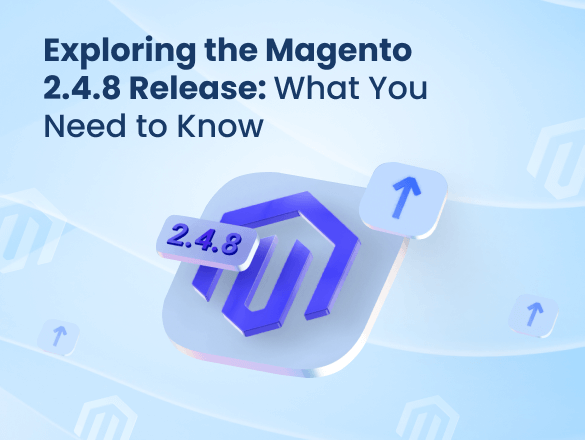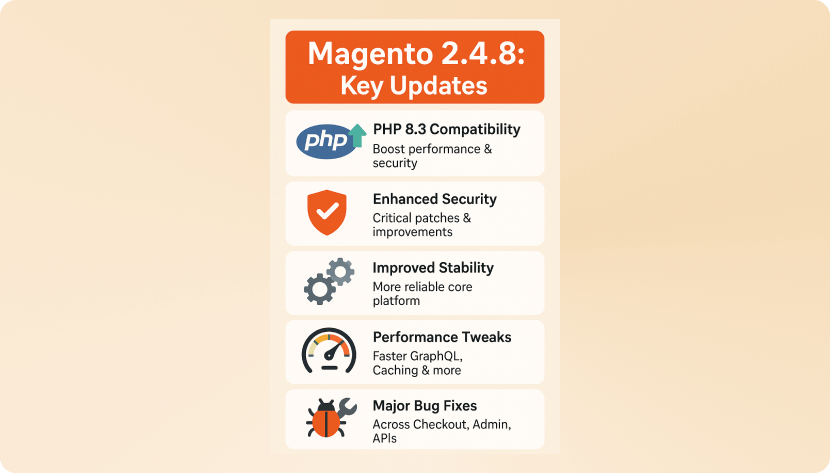Exploring the Magento 2.4.8 Release: What You Need to Know
The Magento 2.4.8 Release date is set for April 8, 2025. Also known as Adobe Commerce 2.4.8, this update focuses on enhancing security, performance, and overall platform stability. While it doesn’t introduce major new features typically seen in minor version upgrades (like 2.5.x), it includes crucial improvements and compatibility updates necessary for maintaining a secure and efficient e-commerce operation. Let’s dive into the key highlights of this release.
Is Magento 2.4.8 Better Than Earlier Versions?
When deciding whether to upgrade from Magento 2.4.7 or older versions to 2.4.8, here’s what merchants need to know.
The main improvements in 2.4.8 focus on making your store more secure, more reliable, and ready for the future. It includes essential security updates for threats discovered since the previous version was released. Keeping your business and customer data safe is crucial, and 2.4.8 offers the latest protection from Adobe, making it clearly “better” for security.
Beyond security, Magento 2.4.8 fixes hundreds of small issues found in version 2.4.7. This means a more stable platform, leading to a smoother experience for your team managing the store and fewer potential hiccups for your customers during shopping or checkout. A significant update is that 2.4.8 works with the newer essential software, most importantly PHP 8.3. Think of PHP as the engine running your store; using the latest version keeps things secure, supported, and potentially faster.
So, is Magento 2.4.8 “faster” than its older versions? It certainly has the potential to be, mainly because it can use the newer, generally quicker PHP 8.3. While Magento itself has some small code improvements, the biggest speed boost opportunity comes from using this updated PHP version on your server. However, simply upgrading Magento won’t guarantee faster speeds. Real-world performance depends heavily on your specific server setup, hosting plan, extensions, and how well everything is configured.
In short: Yes, Magento 2.4.8 is “better” thanks to critical security updates and bug fixes leading to improved stability. It also keeps your store modern by working with the latest technologies like PHP 8.3. While it could be “faster” due to PHP 8.3 support, this requires proper server setup. For merchants on 2.4 or even older, upgrading to 2.4.8 is a recommended step for security and reliability. Just remember to test thoroughly on a staging site before updating your live store!

Considering the Move to Magento 2.4.8?
Ensure your store is secure, stable, and modern with Magento 2.4.8. Take advantage of our expert upgrade service now and receive a $250 discount.
What’s New in Magento 2.4.8?
Key Highlights and New Features
The Magento 2.4.8 Release primarily concentrates on refining the core platform rather than introducing extensive new functionalities. Key highlights include:
- PHP 8.3 Compatibility: A major step forward, this release introduces official compatibility with PHP 8.3, while maintaining support for PHP 8.2. Upgrading to newer PHP versions often brings performance benefits and access to the latest language features and security enhancements.
- Security Enhancements: Security remains paramount. This release incorporates multiple security fixes and improvements designed to protect stores from potential vulnerabilities. These often address issues like Cross-Site Scripting (XSS), Remote Code Execution (RCE), input validation flaws, and session management improvements. Specific details are usually found in the associated Security Bulletin.
- Platform Stability and Quality: Significant effort has been invested in improving the overall quality and stability of the Magento core code. This translates to a more reliable platform, reducing the likelihood of unexpected issues.
Improvements
Magento 2.4.8 brings several advanced improvements across various areas:
- Performance Boosts: While specific benchmarks vary, point releases often include performance optimizations. These can target areas like GraphQL API responses, caching mechanisms (like Varnish), indexing processes, and certain frontend operations, leading to faster load times and a smoother user experience.
- GraphQL Enhancements: Continued improvements to the GraphQL API coverage and performance help headless implementations and PWA Studio users leverage Magento’s capabilities more effectively. Expect better caching, faster query resolution for specific operations, and potentially expanded schema coverage.
- Accessibility Updates: Ongoing efforts to adhere to accessibility guidelines (like WCAG) are typically included, ensuring a better experience for users with disabilities navigating the storefront and potentially the Admin panel.
Updates
This release includes updates to core components and third-party dependencies:
- Core Component Upgrades: Key libraries and frameworks integrated into Magento have been updated to their latest stable versions. This includes updates related to Composer dependencies, JavaScript libraries (like jQuery UI), and other underlying technologies.
- Latest Service Compatibility: Ensures compatibility with the latest versions of supported third-party services, such as:
- Elasticsearch: Updated compatibility details (check release notes for specific supported versions).
- OpenSearch: Continued support and compatibility updates for merchants using OpenSearch as their search engine.
- Redis: Compatibility ensured with recent stable Redis versions for caching and session storage.
- Varnish: Updates to ensure smooth operation with recommended Varnish Cache versions.
- Database: Continued support for compatible versions of MariaDB and MySQL.
Major Fixes
As with any release, Magento 2.4.8 addresses numerous bugs reported by the community and internal teams. While the official release notes contain the exhaustive list, major fixes often target critical areas such as:
- Checkout Process: Resolving issues related to payment methods, shipping calculations, order placement errors, and cart persistence.
- Admin Panel Experience: Fixing bugs related to product management, order processing, customer management, configuration settings, and general usability within the Magento Admin.
- Catalog and Product Management: Addressing problems with price indexing, configurable/bundle product behavior, attribute management, and import/export functionalities.
- API Issues: Correcting bugs within the REST and GraphQL APIs to ensure reliable data exchange for integrations and headless implementations.
- Installation and Upgrade: Smoothing out issues encountered during the installation or upgrade process itself.
What Should I Consider Before Upgrading?
Upgrading to the Magento 2.4.8 Release requires careful planning:
- Review Official Documentation: Thoroughly read the official Magento 2.4.8 Release Notes and the Upgrade Guide provided by Adobe. These documents contain critical details about changes, prerequisites, known issues, and the upgrade process.
- Check System Requirements: Verify that your server environment (PHP version, database versions, Elasticsearch/OpenSearch, etc.) meets the requirements specified for 2.4.8. The introduction of PHP 8.3 support is a key consideration here.
- Extension and Theme Compatibility: Confirm that all third-party extensions and custom themes are compatible with Magento 2.4.8 and PHP 8.3 (if you plan to upgrade PHP). Contact vendors or check their documentation for compatibility information.
- Backup: Always perform a full backup of your Magento filesystem, media, and database before starting the upgrade process.
- Test in Staging: Crucially, perform the upgrade and thorough testing in a staging environment that mirrors your production setup. Test all critical paths: browsing, searching, adding to cart, checkout, admin functions, integrations, etc.
- Use Composer: Follow the recommended upgrade procedure using Composer.
- Plan Downtime: Schedule the production upgrade during a low-traffic period, anticipating potential downtime.
- Seek Expertise: If you lack the technical expertise in-house, consider engaging with an experienced Magento development agency to handle the upgrade.
Focus on your business while Plumrocket takes care of the technicalities. Our upgrade service offers a hassle-free and expert-led process to get your store safely and efficiently onto the latest version.
Conclusion
So, what’s the bottom line of the Magento 2.4.8 Release? Think of it as a crucial tune-up for your online store, focusing squarely on keeping things secure, stable, and running smoothly. Adobe has packed this update with important security patches, made sure it plays nicely with the latest tech like PHP 8.3, updated core components, and squashed a bunch of bugs that could cause headaches. While it might not introduce flashy new storefront features, the improvements under the hood are significant for the health of your e-commerce operation.
If you’re running a Magento 2.4 store or even earlier versions, planning your move to version 2.4.8 should definitely be on your radar. Honestly, staying current is more important than ever, especially when it comes to security – it’s your best defense against potential threats. Yes, upgrading takes effort – you’ll need to plan carefully, test everything thoroughly, and maybe schedule some downtime. If you are unsure about the best approach for upgrading your specific Magento 2 setup, consider a Magento Upgrade Service to get expert consultation and support. Additionally, don’t forget to apply the 250$ discount—just reach out to us and ask for it!





